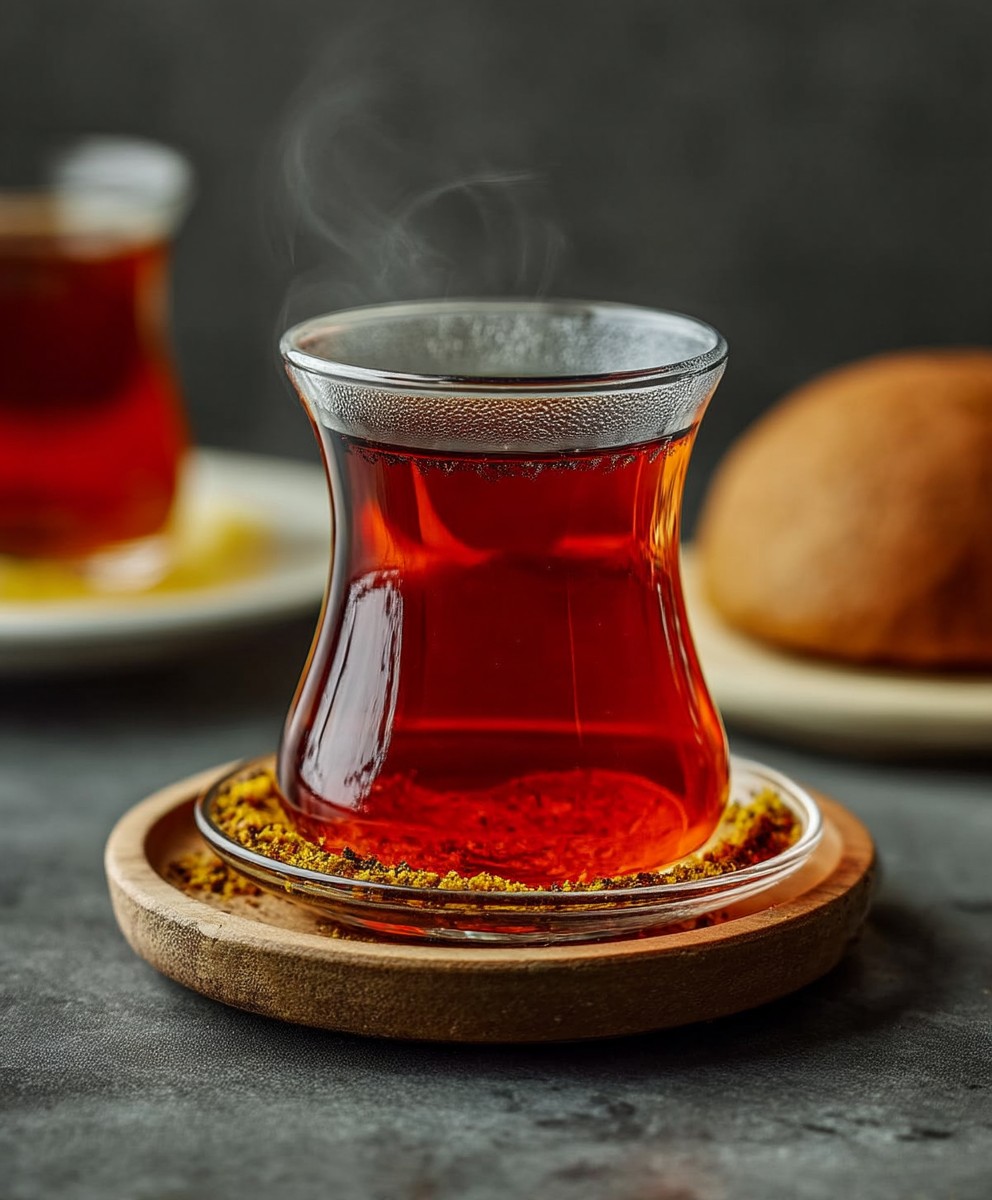Turkish Tea, or “çay” as it’s lovingly called in Türkiye, is more than just a beverage; it’s an integral part of Turkish culture and hospitality. Imagine yourself sitting in a bustling Istanbul cafe, the air thick with the aroma of freshly brewed tea, as you watch the world go by. That’s the magic of Turkish tea! But you don’t have to travel to Türkiye to experience this delight. I’m going to show you how to brew the perfect cup of Turkish tea right in your own kitchen.
The history of tea in Türkiye dates back to the early 20th century, and it quickly became a national obsession. Served in delicate, tulip-shaped glasses, Turkish tea is a symbol of friendship, warmth, and connection. It’s offered to guests as a sign of welcome and enjoyed throughout the day, from breakfast to late-night conversations.
What makes Turkish Tea so beloved? It’s the rich, robust flavor, the beautiful amber color, and the unique brewing method that sets it apart. The double teapot, or “çaydanl?k,” allows for the perfect concentration of tea, ensuring a strong, flavorful brew that can be diluted to your preference. The taste is bold yet smooth, and the ritual of preparing and sharing it creates a sense of community and comfort. So, are you ready to discover the secrets to brewing the perfect cup? Let’s get started!
Ingredients:
- 8 cups of cold, filtered water
- 4 tablespoons of loose leaf Turkish black tea (çay) – preferably a blend
- Granulated sugar, to taste
- Optional: Lemon slices, for serving
Preparing the Turkish Tea Pot (Çaydanl?k)
The key to authentic Turkish tea lies in the use of a double teapot, called a çaydanl?k. This consists of a larger bottom pot for boiling water and a smaller top pot for brewing the concentrated tea. If you don’t have a çaydanl?k, you can use two separate teapots, but the flavor won’t be quite the same. The double boiler effect is crucial for keeping the tea warm and allowing it to steep properly.
Brewing the Tea Concentrate
- Fill the Bottom Pot: Start by filling the larger, bottom pot of your çaydanl?k with 8 cups of cold, filtered water. Using filtered water is important because it avoids any unwanted minerals or flavors that can detract from the tea’s taste.
- Bring the Water to a Boil: Place the çaydanl?k on the stovetop over high heat and bring the water to a rolling boil. This usually takes about 10-15 minutes, depending on your stove. Keep a close eye on it to prevent it from boiling over.
- Add Tea to the Top Pot: While the water is heating, add 4 tablespoons of loose leaf Turkish black tea to the smaller, top pot of the çaydanl?k. The amount of tea can be adjusted slightly to your preference, but this ratio generally provides a strong, flavorful concentrate.
- Warm the Tea Leaves (Optional but Recommended): Some people like to gently warm the tea leaves in the dry top pot over low heat for a minute or two. This helps to release the tea’s aroma and flavor. Be careful not to burn the leaves!
- Pour Boiling Water Over the Tea: Once the water in the bottom pot is boiling, carefully pour about 2 cups of the boiling water over the tea leaves in the top pot. The amount of water you add to the top pot will determine the strength of the tea concentrate.
- Refill the Bottom Pot: After pouring water into the top pot, refill the bottom pot with more cold water. This ensures that you have enough boiling water to dilute the tea later.
- Stack the Pots: Carefully place the top pot onto the bottom pot. The steam from the boiling water in the bottom pot will gently heat the tea leaves in the top pot, allowing them to steep properly.
- Reduce Heat and Simmer: Reduce the heat to low and let the çaydanl?k simmer for at least 15-20 minutes. This is a crucial step for developing the rich, complex flavor of Turkish tea. The longer it simmers, the stronger and more flavorful the tea will become. You’ll notice the tea leaves in the top pot slowly unfurl and release their color.
Serving Turkish Tea
Serving Turkish tea is an art in itself. The key is to achieve the perfect balance between the strong tea concentrate and the hot water, allowing each person to customize the strength of their tea to their liking.
- Use Traditional Tea Glasses: Turkish tea is traditionally served in small, tulip-shaped glasses. These glasses are designed to showcase the tea’s beautiful color and aroma. They also help to keep the tea warm.
- Pour the Tea Concentrate: First, pour a small amount of the tea concentrate from the top pot into the tea glass. The amount of concentrate you pour will depend on how strong you like your tea. A good starting point is about 1/4 to 1/3 of the glass.
- Dilute with Hot Water: Next, carefully pour hot water from the bottom pot into the tea glass to fill it the rest of the way. The hot water dilutes the tea concentrate, creating the perfect balance of flavor and strength.
- Adjust to Taste: Encourage your guests to adjust the ratio of tea concentrate to hot water to their liking. Some people prefer a very strong tea, while others prefer a lighter, more diluted tea.
- Add Sugar: Turkish tea is typically served with sugar cubes. Each person can add sugar to their tea to taste.
- Serve Hot: Turkish tea should always be served hot. The çaydanl?k will keep the tea warm for a long time, so you can enjoy multiple cups.
- Optional: Lemon: Some people enjoy adding a slice of lemon to their Turkish tea. This adds a bright, citrusy flavor that complements the tea’s richness.
Tips for the Perfect Turkish Tea
- Use High-Quality Tea: The quality of the tea you use will have a significant impact on the final flavor. Look for loose leaf Turkish black tea from a reputable source.
- Use Filtered Water: As mentioned earlier, using filtered water is essential for avoiding unwanted flavors.
- Don’t Over-Steep: While simmering the tea for a long time is important, be careful not to over-steep it. Over-steeping can result in a bitter taste.
- Keep the Water Hot: Make sure the water in the bottom pot remains hot throughout the brewing and serving process. This will help to keep the tea warm and prevent it from becoming bitter.
- Clean Your Çaydanl?k Regularly: Over time, mineral deposits can build up in your çaydanl?k, affecting the taste of the tea. Clean it regularly with a mixture of water and vinegar.
- Experiment with Different Teas: There are many different types of Turkish black tea available. Experiment with different blends to find your favorite. Some popular blends include those from Rize and other regions along the Black Sea.
- Enjoy the Ritual: Making and serving Turkish tea is a social ritual. Take your time, relax, and enjoy the process.
Understanding Tea Strength: Demli vs. Aç?k
In Turkish, the strength of the tea is often described as either “demli” (strong) or “aç?k” (weak). This refers to the ratio of tea concentrate to hot water in the glass.
- Demli (Strong): If someone asks for “demli” tea, they want a higher concentration of tea in their glass. You would pour more tea concentrate and less hot water. The color will be a deep, rich reddish-brown.
- Aç?k (Weak): If someone asks for “aç?k” tea, they prefer a weaker tea. You would pour less tea concentrate and more hot water. The color will be a lighter, more translucent reddish-brown.
Knowing these terms will help you serve Turkish tea like a pro and cater to everyone’s individual preferences.
Variations and Additions
While traditional Turkish tea is typically served plain with sugar, there are some variations and additions you can try:
- Lemon: As mentioned before, a slice of lemon adds a refreshing citrusy note.
- Spices: Some people like to add a pinch of cinnamon, cardamom, or cloves to the tea leaves while brewing for a warm, aromatic flavor.
- Rosewater: A few drops of rosewater can add a delicate floral aroma.
- Herbal Infusions: You can experiment with adding small amounts of other herbal teas, such as chamomile or mint, to the top pot along with the black tea.
Storing Turkish Tea
Proper storage is essential for maintaining the freshness and flavor of your Turkish black tea.
- Airtight Container: Store your loose leaf tea in an airtight container to protect it from moisture, light, and odors.
- Cool, Dark Place: Keep the container in a cool, dark place, such as a pantry or cupboard. Avoid storing it near heat sources or in direct sunlight.
- Avoid Strong Odors: Tea can easily absorb odors from its surroundings, so avoid storing it near strong-smelling foods or spices.
- Use Within a Year: For the best flavor, use your Turkish black tea within a year of purchase.
Health Benefits of Turkish Tea
Turkish tea, like other types of black tea, offers several potential health benefits:
- Antioxidants: Black tea is rich in antioxidants, which can help protect your cells from damage caused by free radicals.
- Heart Health: Studies have shown that drinking black tea may help improve heart health by lowering blood pressure and cholesterol levels.
- Improved Focus: The caffeine in black tea can help improve focus and alertness.
- Reduced Risk

Conclusion:
Well, there you have it! I truly believe this recipe for authentic Turkish Tea is a must-try for anyone looking to expand their culinary horizons and experience a taste of Turkish culture. It’s more than just a beverage; it’s an invitation to slow down, savor the moment, and connect with a tradition that has been cherished for centuries. The rich, amber color, the delicate balance of bitterness and sweetness, and the unique brewing method all contribute to an unforgettable sensory experience.
But why is it *really* a must-try? Because it’s surprisingly simple to make, yet delivers a complex and deeply satisfying flavor profile. You don’t need fancy equipment or hard-to-find ingredients. With just a double teapot (or a clever workaround if you don’t have one!), some quality Turkish tea leaves, and a little patience, you can transport yourself to the bustling tea gardens of Istanbul. And trust me, once you’ve tasted the real deal, you’ll never go back to ordinary tea bags again!
Beyond the traditional preparation, there are so many ways to enjoy and personalize your Turkish Tea experience. For a sweeter treat, add a cube or two of Turkish delight alongside your glass. It’s a classic pairing that perfectly complements the tea’s slightly bitter notes. Or, if you’re feeling adventurous, try experimenting with different types of Turkish tea leaves. There are countless varieties available, each with its own unique aroma and flavor profile. Some are more floral, while others are earthier and more robust. Don’t be afraid to explore and find your favorite!
Serving suggestions? Absolutely! Turkish Tea is traditionally served in small, tulip-shaped glasses without handles, allowing you to admire the beautiful color of the tea. Serve it hot, ideally with a small plate of Turkish delight or other sweets. It’s the perfect accompaniment to a leisurely afternoon chat with friends or a quiet moment of reflection. You can also serve it alongside a savory breakfast spread, such as olives, cheese, and fresh bread. The tea’s strong flavor helps to cut through the richness of the food and cleanse the palate.
And for those who prefer a little extra something, a squeeze of lemon can brighten the flavor and add a refreshing twist. In the summer, you can even chill the tea and serve it over ice for a refreshing iced tea variation. Just be sure to brew it a little stronger than usual to compensate for the dilution.
I’m so excited for you to try this recipe and discover the magic of Turkish Tea for yourself. It’s a truly special beverage that I know you’ll love. So, gather your ingredients, follow the steps, and prepare to be transported to a world of flavor and tradition.
Once you’ve made your own batch of this delightful tea, I would absolutely love to hear about your experience! Did you find the recipe easy to follow? Did you make any variations? What did you serve it with? Share your photos and stories in the comments below. Let’s create a community of Turkish tea lovers and share our passion for this amazing beverage! I can’t wait to see what you create! Happy brewing!
Turkish Tea: A Complete Guide to Brewing and Enjoying
Brew authentic Turkish Tea (Çay) in a traditional double teapot (çaydanl?k). Learn to brew and serve this flavorful tea, adjusting the strength to your preference.
Ingredients
- 8 cups of cold, filtered water
- 4 tablespoons of loose leaf Turkish black tea (çay) – preferably a blend
- Granulated sugar, to taste
- Optional: Lemon slices, for serving
Instructions
- Fill the larger, bottom pot of your *çaydanl?k* with 8 cups of cold, filtered water.
- Place the *çaydanl?k* on the stovetop over high heat and bring the water to a rolling boil (10-15 minutes).
- Add 4 tablespoons of loose leaf Turkish black tea to the smaller, top pot of the *çaydanl?k*.
- Gently warm the tea leaves in the dry top pot over low heat for a minute or two (Be careful not to burn the leaves!).
- Carefully pour about 2 cups of the boiling water over the tea leaves in the top pot.
- Refill the bottom pot with more cold water.
- Carefully place the top pot onto the bottom pot.
- Reduce the heat to low and let the *çaydanl?k* simmer for at least 15-20 minutes.
- Use small, tulip-shaped glasses.
- Pour a small amount of the tea concentrate from the top pot into the tea glass (about 1/4 to 1/3 of the glass).
- Pour hot water from the bottom pot into the tea glass to fill it the rest of the way.
- Adjust the ratio of tea concentrate to hot water to your liking.
- Add sugar cubes to taste.
- Serve immediately.
- Add a slice of lemon.
Notes
- Use high-quality Turkish black tea for the best flavor.
- Filtered water is essential for avoiding unwanted flavors.
- Don’t over-steep the tea, as it can become bitter.
- Keep the water in the bottom pot hot throughout the brewing and serving process.
- Clean your *çaydanl?k* regularly to prevent mineral buildup.
- Experiment with different Turkish black tea blends.
- Enjoy the ritual of making and serving Turkish tea.
- “Demli” (strong) tea has a higher concentration of tea. “Aç?k” (weak) tea has a lower concentration of tea.
- Variations: Try adding a pinch of cinnamon, cardamom, or cloves to the tea leaves while brewing for a warm, aromatic flavor.
- Store loose leaf tea in an airtight container in a cool, dark place.





Leave a Comment